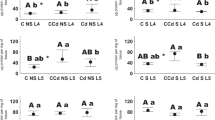Abstract
Heavy metals are essential components of biological systems but are extremely toxic at high doses. As a result, we hypothesized that perception of heavy metals through gustation may exist in Drosophila melanogaster. In this study, we investigated the behavioral effects of iron, copper, zinc, and cadmium on D. melanogaster gustation, oviposition, and pupation-site selection. In addition, we examined the biological effects of heavy metals on the fruit fly survival and reproductive success. Our results illustrate that D. melanogaster responds behaviorally to the presence of high concentrations of heavy metals in food. All metals acted as repellents to the fruit flies at high doses, with the egg-laying and feeding of the female flies significantly decreasing. Furthermore, supplementation of heavy metals in the culture medium reduced survival to the adult stage and shortened the life span of adult flies. From these observations, we speculate that D. melanogaster avoidance behavior towards high concentrations of heavy metals may have a positive effect on their survival and reproductive success in nature, particularly in the presence of metal-contaminated food sources.






Similar content being viewed by others
References
Amrein H, Thorne N (2005) Gustatory perception and behavior in Drosophila melanogaster. Curr Biol 5(17):R673–684
Anderson PR, Kirby K, Hilliker AJ, Phillips JP (2005) RNAi-mediated suppression of the mitochondrial iron chaperone, frataxin, in Drosophila. Hum Mol Genet 14(22):3397–3405
Anholt RR, Mackay TF (2001) The genetic architecture of odor-guided behavior in Drosophila melanogaster. Behav Genet 31(1):17–27
Bahadorani S, Mukai S, Egli D, Hilliker AJ (2008) Overexpression of metal-responsive transcription factor (MTF-1) in Drosophila melanogaster ameliorates life span reductions associated with oxidative stress and metal toxicity. Neurobiol Aging. In press
Balamurugan K, Egli D, Hua H, Rajaram R, Seisenbacher G, Georgiev O, Schaffner W (2007) Copper homeostasis in Drosophila by complex interplay of import, storage and behavioral avoidance. EMBO J 26(4):1035–1044
Chen X, Zhang B, Harmon PM, Schaffner W, Peterson DO, Giedroc DP (2004) A novel cysteine cluster in human metal-responsive transcription factor 1 is required for heavy metal-induced transcriptional activation in vivo. J Biol Chem 279(6):4515–4522
Chyb S, Dahanukar A, Wickens A, Carlson JR (2003) Drosophila Gr5a encodes a taste receptor tuned to trehalose. Proc Natl Acad Sci USA 100:14526–14530
Dahanukar A, Hallem EA, Carlson JR (2005) Insect chemoreception. Curr Opin Neurobiol 15(4):423–430
Devaud JM (2003) Experimental studies of adult Drosophila chemosensory behaviour. Behav Processes 64(2):177–196
Egli D, Selvaraj A, Yepiskoposyan H, Zhang B, Hafen E, Georgiev O, Schaffner W (2003) Knockout of ‘metal-responsive transcription factor’ MTF-1 in Drosophila by homologous recombination reveals its central role in heavy metal homeostasis. EMBO J 22(1):100–108
Egli D, Yepiskoposyan H, Selvaraj A, Balamurugan K, Rajaram R, Simons A, Multhaup G, Mettler S, Vardanyan A, Georgiev O, Schaffner W (2006) A family knockout of all four Drosophila metallothioneins reveals a central role in copper homeostasis and detoxification. Mol Cell Biol 26(6):2286–2296
Eisses KT (1997) The influence of 2-propanol and acetone on oviposition rate and oviposition site preference for acetic acid and ethanol of Drosophila melanogaster. Behav Genet 27(3):171–180
Ferenci P (2004) Pathophysiology and clinical features of Wilson disease. Metab Brain Dis 19(3–4):229–239
Fox GA (1993) Failure-time analysis: emergence, flowering, survivorship, and other waiting times. In: Scheiner SM, Gurevitch J (eds) Design and analysis of ecological experiments. Chapman and Hall, New York, pp 253–289
Hallem EA, Carlson JR (2004) The odor coding system of Drosophila. Trends Genet 20(9):453–459
Hallem EA, Dahanukar A, Carlson JR (2006) Insect odor and taste receptors. Annu Rev Entomol 51:113–135
Halliwell B, Gutteridge JM (1986) Oxygen free radicals and iron in relation to biology and medicine: some problems and concepts. Arch Biochem Biophys 246(2):501–514
He ZL, Yang XE, Stoffella PJ (2005) Trace elements in agroecosystems and impacts on the environment. J Trace Elem Med Biol 19(2–3):125–140
Heimbeck G, Bugnon V, Gendre N, Haberlin C, Stocker RF (1999) Smell and taste perception in Drosophila melanogaster larva: toxin expression studies in chemosensory neurons. J Neurosci 19(15):6599–6609
Jin R, Huang J, Tan PH, Bay BH (2004) Clinicopathological significance of metallothioneins in breast cancer. Pathol Oncol Res 10(2):74–79
Massadeh A, Al-Momani F, Elbetieha A (2008) Assessment of heavy metals concentrations in soil samples from the vicinity of busy roads: influence on Drosophila melanogaster life cycle. Biol Trace Elem Res 122(3):292–299
Massie HR, Aiello VR, Williams TR (1985) Iron accumulation during development and ageing of Drosophila. Mech Ageing Dev 29(2):215–220
Nelson N (1999) Metal ion transporters and homeostasis. The EMBO Journal 18(16):4361–4371
Norgate M, Lee E, Southon A, Farlow A, Batterham P, Camakaris J, Burke R (2006) Essential roles in development and pigmentation for the Drosophila copper transporter DmATP7. Mol Biol Cell 17(1):475–484
Orgad S, Nelson H, Segal D, Nelson N (1998) Metal ions suppress the abnormal taste behavior of the Drosophila mutant malvolio. J Exp Biol 201(Pt 1):115–120
Phillips JP, Hilliker AJ (1990) Genetic analysis of oxygen defense mechanisms in Drosophila melanogaster. Adv Genetics 38:43–71
Rogers JT, Lahiri DK (2004) Metal and inflammatory targets for Alzheimer’s disease. Curr Drug Targets 5(6):535–551
Thorne N, Chromey C, Bray S, Amrein H (2004) Taste perception and coding in Drosophila. Curr Biol 14(12):1065–1079
Acknowledgements
This work was supported by a grant from the Natural Sciences and Engineering Research Council (NSERC) of Canada to A.J.H.
Author information
Authors and Affiliations
Corresponding author
Rights and permissions
About this article
Cite this article
Bahadorani, S., Hilliker, A.J. Biological and Behavioral Effects of Heavy Metals in Drosophila melanogaster Adults and Larvae. J Insect Behav 22, 399–411 (2009). https://doi.org/10.1007/s10905-009-9181-4
Revised:
Accepted:
Published:
Issue Date:
DOI: https://doi.org/10.1007/s10905-009-9181-4




